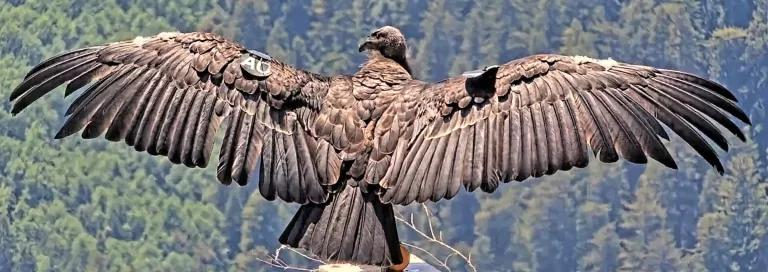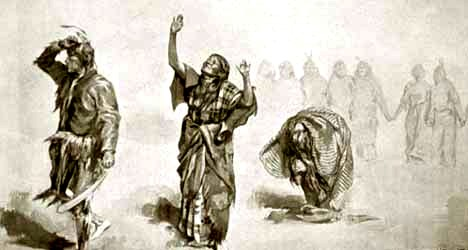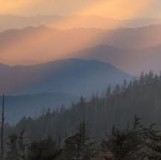
Seven years ago, I stood atop a sagebrush bluff in eastern Oregon, waiting for the coming total eclipse of the sun. As we gathered and talked and laughed, the air cooled and the yellow landscape faded into muted tones. Ten minutes before totality, in a half-light like some strange Instagram filter, a Brewer’s Sparrow started singing. Three minutes to go, Venus appeared almost directly overhead. The sky in the west sank into a deep velvety midnight blue, as if blackness was pouring down from the heavens. Distant smoke from a fire on the southern horizon lit up like a sunset. Two minutes to go. Darkness spread from the west, threatening to envelope us. The crowd began to exclaim, “It’s coming!” and “Oh my God!” And, then, suddenly, we looked up, and there it was– floating in cool peaceful stillness, a perfect black disc surrounded by a silky silver corona. In its serene beauty, it seemed to be looking at us. Benevolently. It felt much closer to me than the sun normally feels, perhaps just a few thousand feet up. It was real; everything else was surreal.
On April 8, a much larger solar eclipse – over four minutes of totality, and with the moon fully five percent larger than the sun – will sweep from Mazatlán to Quebec.
Dramatic portents of the future, total solar eclipses have played a significant role in Native history, featuring prominently in political movements and spiritual revivals. Here are two of the most recent examples.
June 16, 1806
Sitting in his plantation-style mansion along the Wabash River, Governor William Henry Harrison was working hard to get title to Native land, to open it up to land speculators, such as his father-in-law, John Cleves Symmes. But he was hearing rumors of revolution from the White River country. Tecumseh’s brother, the one they called the Prophet, was calling for the Shawnee and others to renounce the ways of the white man and return to their traditions.
Harrison challenged him: “Who is this pretended prophet who dares speak in the name of the Great Creator? If he is really a prophet, ask of him to cause the sun to stand still.”
Two months later, at 10:41am on June 16, from the White River to Detroit, from the Mississippi River to Boston, the sky went dark, the air cooled, crickets chirped and robins sang. Stars came out and, for four and a half minutes, the sun turned into a black hole framed by an ethereal silver radiance, as if the Creator was looking right at you.
Tecumseh’s trans-tribal campaign to push back the American and British armies was later assisted by two more natural phenomenon. In the fall of 1811, as he traveled thru Chickasaw, Choctaw, Cherokee, and Muscogee (Creek) lands to build a Native alliance from the Great Lakes to the Gulf of Mexico, a light appeared in the sky – a great comet with a long tail. It grew brighter each night, easily visible to the naked eye. It was Haley’s Comet. And everyone new that “Tecumseh” meant “shooting star.”
That winter, with the comet still visible, the massive New Madrid earthquakes, up to 8.2 on the Richter Scale, shook the entire region, temporarily reversing the flow of the Mississippi River. Another sign.
January 1, 1899
Around 2pm, in northern Nevada, as land and sky turned dark, stars appeared, and the pearly corona exploded around a perfect black hole in the heavens, Wovoka of the Northern Paiute saw more than all this. He saw a new earth, filled with the resurrection of the dead, living in peace as in times of old, in a land teeming with deer and buffalo.
His vision spread throughout the West, from reservation to reservation. Tribes sent emissaries. The vision grew. There will be no hunger, disease, or death; no tears, pain, or mourning. The whites will sink into the soil. All will be made new. This will come to pass if the people perform the Ghost Dance.
What happened next is well-known: Sitting Bull was assassinated and the 7th Cavalry took revenge on hundreds of women and children at Wounded Knee, for the crime of dancing.
April 8, 2024
And yet, now, Wovoka’s vision is taking root, even without the coming eclipse.
The Haudenosaunee (Iroquois) Council Fire still burns today, and the Six Nations still cross the border that crossed them at Niagara Falls. The birch bark scrolls are back in Anishinaabe (Ojibwe (Chippewa), Odawa, and Potawatomie) hands. The land of Oneida County once again feels the stomp of Oneida feet. Ho-Chunk lands feel the stomp of elk hooves. The Cherokee woods may be in a new place, but the stomp dances never stopped. Lenape (Delaware) hear their own drums in Manhattan. The Shawnee now tell the story of the Great Serpent Mound.
Wounded Knee had to be bought from a white couple at an inflated price, but now that land is back with the Lakota. The bars in Whiteclay have closed. The Arapaho boys have been repatriated from Carlisle to Wind River, the nine Sicangu to Rosebud. The Kiowa are re-acquiring the lands promised to them at Medicine Lodge. The Sacred Pole is back with the Omaha. The National Bison Range is now managed by the Confederated Salish and Kootenai Tribes. The buffalo herd at Osage Nation Ranch is growing.
The Salish Sea is caressed by the paddles of pullers, on their way to protocol. The Elwha River runs free again, and the Klallam are catching coho. The Colville Confederated Tribes are restoring wolves, lynx, and bighorn sheep from the Cascades to the Rockies. The Snoqualmie are re-recognized and the mist of the falls that bears their name still carries their prayers to the heavens. The Cahuilla oversee the restoration of desert bighorn sheep. And condors soar across Yurok skies.
On April 8, when the Creator looks through that great hole in the sky, they will see all this. Indeed, they see it now.




Thank you for reminding us that even in these calamitous times there is renewal.
I really love reading this history, and also knowing you’re an avid birder since age seven.